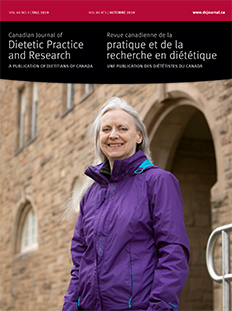Dans la conférence commémorative Ryley-Jeffs intitulée
Embracing the Strength in Difference [Accueillir la force dans la différence], prononcée par Laurie Wadsworth au congrès 2019 des Diététistes du Canada et présentée dans ce numéro, M
me Wadsworth utilise la mise en récit et s’appuie sur des données probantes pour mettre en lumière les principaux enseignements et défis qui ont ponctué sa carrière diversifiée. Fière lauréate du prix commémoratif Ryley-Jeffs, M
me Wadsworth a accueilli la force dans la différence et s’est distinguée par ses rôles de leader, contribuant ainsi grandement à la profession, tout en incarnant la vision de Violet Ryley et Kathleen Jeffs. Toutes nos félicitations!
L’un des exemples étonnants qu’elle a fournis dans « différentes façons de savoir » était une discussion autour du mauvais usage de la signification statistique qui a été citée dans un éditorial paru récemment dans
Nature. Les critiques à l’égard des valeurs-
p ont commencé à gagner du terrain lorsque l’American Statistical Association (ASA) a publié une
déclaration sur la signification statistique et les valeurs-p comportant six principes décrivant l’interprétation et l’utilisation appropriées de la valeur-
p. Au cœur de l’enjeu se trouve la valeur-
p (
p pour probabilité), qui est utilisée pour montrer dans quelle mesure les résultats scientifiques sont convaincants; les faibles valeurs-
p étant considérées comme éloquentes, de sorte que les études ne sont pas souvent répétées. Or, la valeur-
p peut varier considérablement si une étude est reproduite, ce qui la rend peu fiable et en fait une piètre mesure de la solidité des données probantes. Un éditorial mis à jour paru dans un numéro spécial de la revue de l’ASA intitulé
A World Beyond p < 0.05 [Un monde au-delà de
p < 0,05] réitère qu’il est temps de cesser d'employer le terme « statistiquement significatif » [
1]. Bien qu’aucune solution unique ne soit avancée, on suggère de comparer les groupes et les études directement en montrant des valeurs-
p continues et des estimations d’intervalles de confiance pour les différences, tout en reconnaissant que « l’incertitude est présente partout dans la recherche » [
1]. Éliminer la dichotomie que représente la signification statistique constitue une façon très différente d’envisager la recherche. Ainsi, nous espérons que des statisticiens plus avant-gardistes nous aideront à présenter et à interpréter les données.





